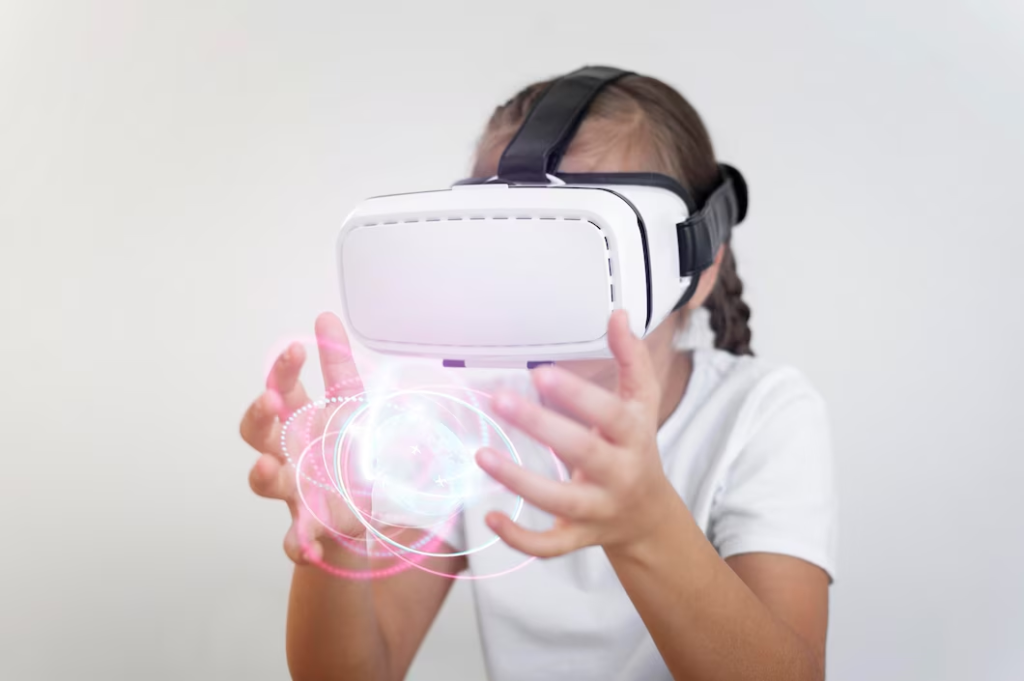The metaverse could become the next evolution of the internet, providing immersive three dimensional virtual worlds where people can collaborate, play and work collaboratively. 2023 will mark a critical turning point in its creation with tech titans such as Meta leading the charge in developing it further. We’ll delve deep into what the metaverse entails – its technological innovations driving its expansion, key players shaping its development process as well as potential use cases that might impact lives as part of this lengthy blog post.
What is the Metaverse?
A “metaverse” refers to an online space which brings physical, augmented and virtual realities together in one shared place. This world comprises multiple elements including but not limited to physical reality (such as 3D printing) as well as other virtual forms like gaming or chatbots.
- Persistent 3D virtual worlds that continue to exist and develop even when not actively used or watched allow multiple simultaneous users to interact with each other as well as with their environment.
- An emerging virtual economy where users can purchase digital assets and services with cryptocurrency or fiat money is emerging; virtual jobs could even replace real ones in future.
- Are You Looking to Establish or Edit a Digital Persona and Avatar in Virtual World? Are You interested in creating unique digital identities, avatars or personas to represent users in Virtual Reality (VR) environments? Users have opportunities for creating distinct virtual personas through fashion accessories or customization of clothing for avatars that represent themselves in VR world. Users have full customization over what their avatar wears/accessorises in terms of clothes/accessories worn / styles chosen etc..
- Social connection through real-time interactions among users regardless of physical locations, using text, voice and video channels of communication.
- Continued continuity between platforms and virtual worlds is necessary in order for avatars, identities and assets to carry over between platforms or virtual realities; interoperability among technologies must also exist here.
Metaverse technology serves to simulate various real-life human interactions and activities within persistent virtual spaces, similar to real life. Here are a few things you can do in the metaverse:
- Attend virtual events such as concerts, conferences, lectures and parties attended by large audiences of users.
- Enjoy engaging games ranging from simple quests to immersive virtual worlds that provide both gameplay and economic opportunities.
- Collaborate on work projects remotely in an office-like virtual setting.
- Try on and purchase digital clothing or accessories like sneakers, hats or handbags for your avatar like sneakers, hats and handbags from digital vendors.
- Purchase virtual land to build customizable homes or structures upon it.
- Explore elaborate virtual environments based on locations and activities found in the physical world, taking trips around the planet without ever leaving your own home.
- The metaverse’s possibilities are nearly limitless.
By liberating us from physical space limitations while increasing online interactions via virtual reality, its vast expanse opens up creative, economic and societal opportunities we might otherwise miss out on. Imagine an online experience beyond content consumption or posting to social media – transform how collectively we experience internet.
Key Technologies Powering the Metaverse
Technology Driven Metaverse Today, key technologies have advanced enough for their vision of an immersive metaverse to become reality:
VR/AR Headsets –

Today’s virtual and augmented reality (VR/AR) headsets have become highly advanced yet increasingly affordable, such as Meta’s Oculus Quest 2 at just $399 or cheaper from other brands. These immersive 3D experiences allow users to immerse themselves into vast 3D worlds while interacting in intuitive yet natural ways through movement-controlled interactions between worlds.
5G Networks –

These next-gen wireless networks deliver the high bandwidth, ultra-low latency, and consistent speeds required to make a robust metaverse possible. 5G enables virtual worlds hosting millions of concurrent users as well as real-time interactions even between mobile devices.
Cloud Infrastructure –

Extensive data centers featuring cloud computing provide the backend infrastructure necessary for rendering 3D worlds, storing vast user information databases and running artificial intelligence programs. Companies like Meta have formed partnerships with AWS, Google Cloud and Microsoft Azure in order to scale-up quickly.
Blockchain & Digital Assets –

Blockchain technology empowers users to create virtual assets they own and trade securely and transparently; such as clothing, art and music digital downloads – providing security and scarcity in virtual economies.
Edge Computing –

Edge computing brings data closer to users for quicker AR/VR experiences by decreasing latency, and complements 5G networks and data centers by offering real-time metaverse experiences.
AI, CGI & Graphics –

Artificial intelligence, computer generated imagery (CGI), and advanced graphics like Ray Tracing enable detailed representations of people, objects and environments within the metaverse; photogrammetry scans real objects for scanning purposes.
Spatial Computing –

Spatial computing technology allows digital content and information to be connected to specific physical locations for more immersive experiences blending the real with the virtual. It has proven essential in creating truly engaging immersive experiences between real life and virtuality.
Touch Feedback –

Haptics and tactile feedback technologies bring physical tactility into interactions between virtual objects and characters in the metaverse and users themselves. Force feedback gloves allow them to feel physical objects such as tools or balls in their hands.
Major Players Driving Metaverse Growth
Given its vast potential, major tech companies are racing to claim their piece of the metaverse. Here are some of the main players currently:
Meta (Formerly Facebook) –
This company is pouring millions of dollars into building out their metaverse, investing more than $10 billion this year alone and hiring thousands of engineers worldwide. They focus on social, gaming and workplace applications with VR headsets while their Horizon Worlds platform represents their initial attempt at expanding it further.
Microsoft –
Microsoft is rapidly adopting metaverse capabilities into popular platforms like Teams and Xbox, while investing heavily in gaming and the metaverse with Activision Blizzard for $68.7 billion as it places bets in gaming as well. Furthermore, HoloLens 2 augment reality headset is also offered by them for multipurpose use.
Google –
Google is expanding their AR experiences like Live View and Maps into the metaverse realm, as well as exploring prototypes to advance hardware. Furthermore, their cloud platform and smart home efforts will facilitate interconnectivity that is required by this concept of a virtual universe.
Apple –
With over one billion iOS devices around the world and their high-end AR/VR headset rumor circulating widely among iPhone and iPad users worldwide, Apple offers one of the world’s most widely utilized AR platforms. Their ecosystem of devices, apps and developers make them essential participants in creating metaverse applications and experiences.
Nvidia –
Nvidia’s powerful graphics processing units and Omniverse platform play an instrumental role in metaverse creation – from virtual worlds to the creation of digital twins of real objects or environments in reality. Furthermore, Nvidia recently purchased ARM to advance chip design for AR/VR devices.
Unity –
The cross-platform game engine developed by Unity has become widely utilized to construct virtual worlds across industries and media types. Being at the forefront of 3D content creation tools, it continues to partner extensively with metaverse initiatives worldwide.
Autodesk –
Autodesk provides several 3D design and engineering tools used for modeling objects and environments within the metaverse, with its Maya 3D animation software being widely employed by leading metaverse projects and games.
AMD –
performance semiconductors such as CPUs and GPUs needed for rendering detailed virtual worlds, working closely with companies on customized chips to enable next-gen visuals and immersion experiences.
Adobe –
Adobe is widely known for their content creation tools that assist in modelling 3D assets, animating scenes and designing user interfaces in the metaverse. Their substance toolset provides texture creation for realistic materials.
Shopify –
Shopify powers over one million online businesses and will play an essential role in virtual e-commerce within the metaverse. Merchants using Shopify’s platform can easily develop virtual shops to sell digital items.
Also read here- Exploring AI: How Artificial Intelligence is Transforming Industries
How the Metaverse Could Impact Our Lives
Open, interoperable metaverse platforms could have significant ramifications on many aspects of everyday life. Here are a few ways it could have an effect on how we live, work, socialize and conduct business:
Remote Work and Collaboration –
The metaverse allows more effective remote work, collaboration and communication between coworkers as if they were physically present. Establishing an engaging virtual office space helps bridge this divide when working remotely.
Virtual Healthcare –
Virtual clinics, counseling services and AI health assistants within the metaverse could offer patients improved accessibility and convenience for healthcare services. VR therapy has already proven itself effective against conditions like posttraumatic stress disorder (PTSD), anxiety and chronic pain.
Immersive Shopping –
Online shopping can take an immersive approach through expansive virtual malls and product showrooms, featuring major fashion labels selling virtual apparel for avatars.
Training and Education –
Virtual reality training simulations have long been used as an efficient method of quickly teaching complex tasks from construction to surgery, making a real impactful statement about virtual world technology’s growing applications in education as virtual classrooms or museums become available online. The metaverse offers immense possibilities for hands-on learning with its virtual environments offering virtual classrooms or museums for virtual hands-on experience.
Virtual Events and Tourism –
Virtual reality allows attendees to attend music concerts or major sporting events without actually travelling there physically, and virtual tourism allows exploring locations without physically travelling there.
Gaming and Entertainment –
Popular online games such as Fortnite, Roblox and Minecraft incorporate elements designed to bring joy to their users through immersive worlds that blend social experiences with virtual economies.
Industrial Applications –
The metaverse facilitates 3D visualization of complex datasets, remote control of machinery and collaborative design review meetings using digital twins; creating opportunities to streamline operations and workflows.
Real Estate –
Virtual real estate and property can already command millions in sales prices, often surpassing physical properties in value. Through the metaverse, ownership barriers may be reduced for land ownership as well as personalizing homes to your liking; you can gain unique addresses by buying NFTs associated with blockchain domains.
Decentralized Networks –
Cryptocurrency payments integrated with metaverse platforms provide transaction transparency by eliminating fees and intermediaries while decentralization opens these virtual economies up for wider participation while giving users more control.
With some concerns related to increased screen time, data privacy and content moderation lingering among society, overall momentum towards adopting metaverse experiences seems strong. Mobile phones and social media have revolutionized business interactions; now the metaverse will usher us all towards an interconnected and immersive future that improves both our physical lives as well as digital interactions. Over the coming years we will witness rapid advancement towards realizing this ambitious vision as it transitions from hype into mainstream society.



